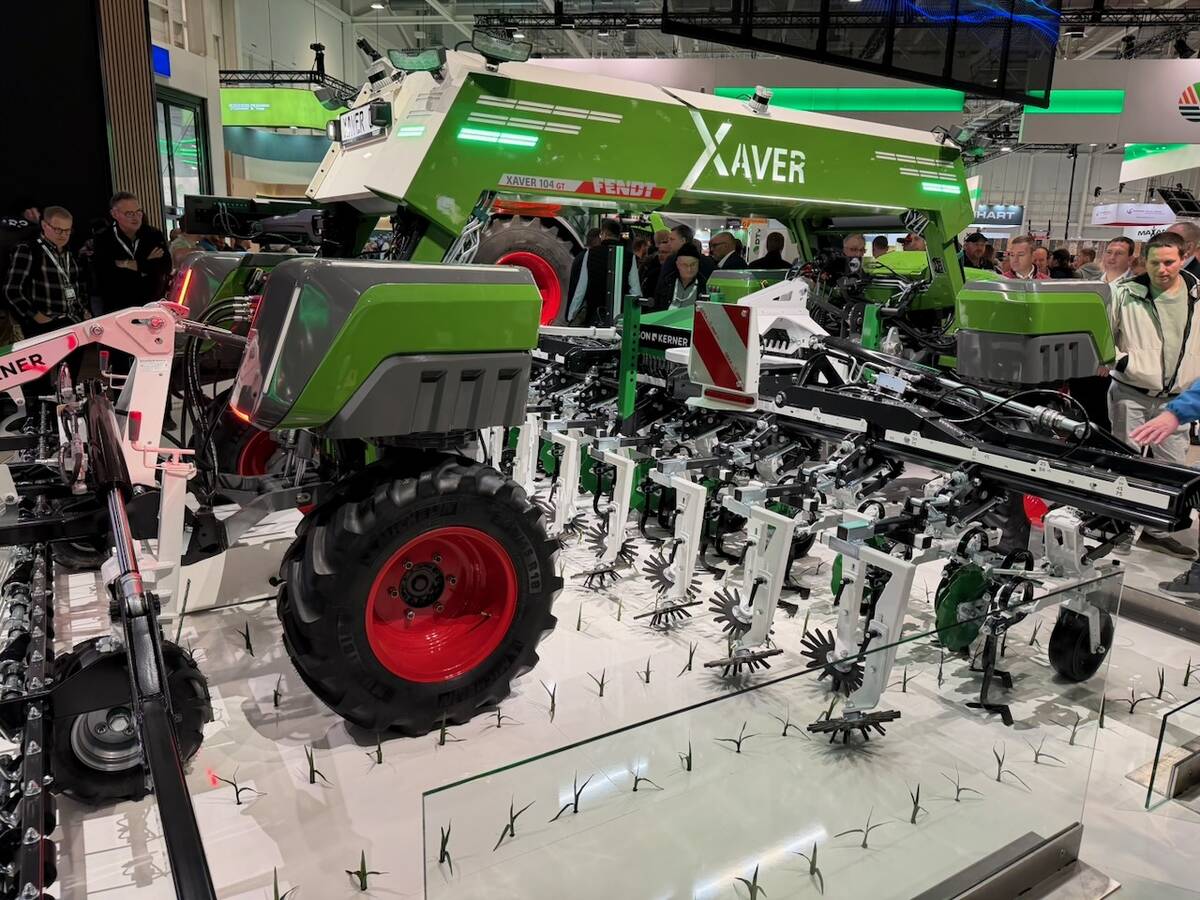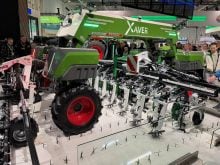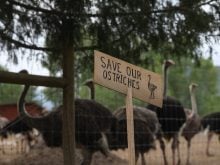REGINA – A quick turn, the kind people make when they think they have left the stove on, sends Bob Jackson scuffling across straw-strewn concrete.
He covers the 100 metres between his barn and the arena show ring faster than a calf returns to its mother after branding.
A radio slung on the hip of a nearby maintenance worker crackles: “I’ve got a barn boss here. He says he wants it redone. The harrowing. He wants it redone. Says it’s too rough, too soft. Yeah, all of it. Redone.”
Read Also

VIDEO: Agritechnica Day 4: Robots and more robots, Nexat loves Canada and the trouble with tariffs
Agritechnica Day 4: Robots and more robots, Nexat loves Canada and the trouble with tariffs.
The barn boss, Jackson, tosses some of the loose dirt covering the wood over the arena’s ice surface with the toe of his cowboy boot.
“I like to head things off early. If I don’t get it done now, by noon we’ll be second in the show ring and this place will be an uneven, lumpy mess. The cattle won’t stand straight and the breeders will be upset,” said the cattle producer from Sylvania, Sask.
It is just after 6 a.m., the start of the seventh day of what will be for Jackson and his wife, Janet, a nine-day week.
Bob Jackson is the Charolais barn boss at Canadian Western Agribition. Without him and 26 other barn bosses, confusion would reign at Western Canada’s largest livestock show held in Regina every November.
Twice named barn boss of the year, Jackson relies on his experience to keep order in his barn and his farmers blissfully unaware of the planning and work involved in getting the show up and running.
Bob and Janet start planning for Agribition months before the event begins, attending livestock fairs in Brandon, Man., and Saskatoon. Bob asks breeders their plans for Agribition: how many animals they plan to bring, and the animals’ genders and ages.
BOB and Janet then create a stall map to show where each animal would be located in the Agribition’s Charolais barn, all 199 of them.
“As barn boss you need to know who gets along. There can be a lot of politics in the cattle business and you need to know who works best with whom. Nobody needs to be thinking about how all this happens. They just show up and unload and get to work,” he said.
It’s Nov. 21, a Saturday – the day before opening day in Regina, and Jackson and his staff are checking the barn for electricity, stalls, straw, woodchips and other necessities.
Most Charolais producers won’t arrive for three more days, when the purebred cattle competitions begin.
This year, for the first time in three years, Bob and Janet’s farm Bo-Jan Enterprises is showing cattle at the event.
Jackson felt he couldn’t be both an effective barn boss and show his own cattle so he hired two experienced fitters to transport, prepare and show Bo-Jan’s cattle.
On Monday, more cattle begin to arrive.
By Tuesday, there’s a steady flow of animals into the barn and most purebred cattle at Agribition, 1,822 in all, are on the grounds and moving toward their pens. Younger animals buck and stall, older experienced show cattle wander slowly behind their owners.
In the midst of the confusion, thousands of schoolchildren, families, farmers and cattle buyers jostle through the congested alleys.
The Charolais barn is situated on a major thoroughfare. Most of the 150,000 people who take in the eight-day event must pass the blond-colored cattle to get from one side of the exhibition park to another.
Jackson pressures breeders to keep their fitting chutes out of the alleyways. Tack boxes and extension cords pile up. Jackson prods owners to tidy up and keep their areas safe for passers by.
The Charolais barn is one of the oldest, part of Regina’s original exhibition park. The wiring is old, designed for less mechanized times. Jackson’s barn uses two separate generators: a large diesel unit and a gas powerplant brought by a breeder.
Wednesday, shortly before 8 a.m., Jackson seeks out the maintenance supervisor.
“The generator is on less than half a tank. Can we catch it before lunch?” he says.
Jackson explains the intricacies of cattle barn politics.
“If you ask the wrong person for help or even the right person that you’ve given a hard time to in the past, you might just not get your fuel or whatever else you need. They know who they are. They need to know who you are. You need to give them some respect.”
AT 9 a.m. the barn bosses gather to talk about the day’s events and address complaints about facilities. The tie-out boss gives a report on animals that were running loose the night before. They plan traffic routes through the barns for upcoming shows.
Jackson will be in the middle of that traffic, answering questions and making deals for space and services.
All day long, breeders seek out Jackson:
“Where are the breakers?”
“Where am I stalled?”
“Are the show books here?”
“I need my show cards, are they ready yet?”
“Can I have my chute here?”
“Can we turn off the heat?”
“Can we turn on the heat?”
When the day is done, handlers tie out the cattle for the night, but the Jacksons are still at work.
Janet runs the Charolais office, while Bob flags down skid steer loader operators to arrange for manure removal. Then he pushes a broom for an hour before he is satisfied his barn is clean.
“Clean barns reflect well on the breed. The public opinion of our breed is important and we see a lot of public here,” he says.
In addition to raising his own cattle, Jackson is president of the Saskatchewan Charolais Association and the 1998 breeder of the year.
It’s Friday; show day for the Charolais barn.
Jackson has already anticipated the winners and has strategically placed the favorites away from the main isles to allow for victory celebrations.
For an hour in the fading afternoon he eats a quiet, late lunch while sitting in the stands with 1,500 other people. He speculates on the quality of the young bulls 20 metres away.
Until now, he has had little time to look at the animals.
The hour passes quickly and soon it is time to get moving again. Somebody is trying to flag him down from the show ring floor. Another question. Then back to the barns before the big winners return with the crowd.
His plans pays off. More than 370 people are in the barn after the Charolais breed show ends early Friday evening.
JACKSON congratulates the winners, while quietly closing their tackbox/liquor cabinets. He hands out anonymous plastic cups and everyone amiably complies. Beer cans disappear from view and liquor bottles are stowed into plywood cabinets. Jackson hasn’t said a word, just smiled.
This year Bob is breaking in another would-be barn boss. A younger man is interested in taking over, but it will take a couple of years to make the transition. The job isn’t a money maker. The $1,000 for the week must cover all expenses. Jackson expects to lose money, not including the cost of the fitters he has hired.
But one of his heifers has placed first in her class and he sold another that placed well. That money will pay for the fitters, but Jackson wants to participate in the show as a breeder and not a barn boss.
By next spring, he and Janet will begin planning for next year’s show. By summer they will have a plan and before the show opens next November, his penning blueprint will include the knowledge gained from the last eight days.














